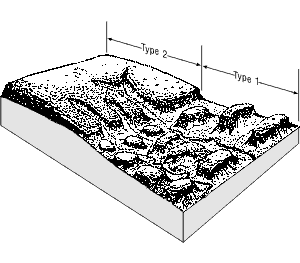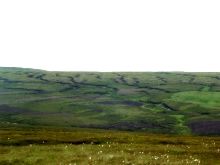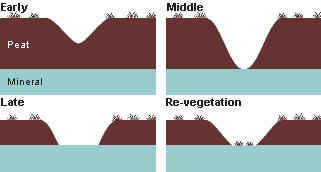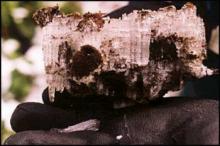Geomorphology is the study of landforms. We will look briefly at the patterns of peat erosion and the geomorphic processes which erode the peat and created the resulting landscape.
Patterns of peat erosion
Bower (1961) identified two principal forms of gully erosion from aerial photographs as shown in the diagram opposite.
TYPE 1 erosion


(after Bower, 1961)
- Occurs on flat, or low angled slopes (<5 degrees).
- Creates a intricately branching, dendritic pattern of erosion.
- Is a closed gully system with much branching.
- Forms a landscape of many isolated hags, scattered on a large expanse of bare, exposed peat.
- Occurs where water erosion dominates.
- Thought to be created by a linking of pool/hummock complexes.
TYPE 2 erosion

- Occurs on steeper, sloping ground.
- Creates long, straight, unbranching gullies.
- Gullies formed into sub-parellel trenches downslope.
- Is a more open gully system, with reduced branching.
- Occurs where water erosion and mass movement mechanisms are in operation.
Gully erosion

There are thought to be four stages of gully erosion:
- Early stage - linkage of pools & creation of gullies in peat.
- Middle stage - gullies to the full depth of the peat - v-shaped.
- Late stage - large eroded flats & box profile gullies.
- Occasional development of bare peat flats (like at Bleaklow Head).
- Occasional re-vegetation of mineral soils (see at Bleaklow).
Processes of peat erosion
Initial studies of peat erosion in the Pennines by Bower concluded that the principal erosion mechanisms over the South Pennines were:
- water erosion,
- and to a lesser extent, mass movement.
Radley's theory of peat erosion however focuses on wind erosion.
Frost action (needle ice formation)

- This is an erosion mechanism which occurs during the winter.
- Needle ice forms readily on saturated bare peat surfaces on cold clear nights.
- Water is drawn towards the freezing front at the surface and freezes as needle shaped crystals.
- Typically these layers of needle ice are capped with a thin layer of peat which has been heaved above the surface.
- When the ice melts this material is left as a layer of loose peat over the surface.
- This peat is readily removed by the wind or by subsequent rainfall.
- 'Weathering' of the peat surface through needle ice action is one of the main mechanisms enhancing the susceptibility of bare peat to erosion.
Now continue with your visit to the themes pages, and consider water quality in the Dark Peak.